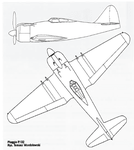Shortround6
Lieutenant General
The Piaggio 18 cylinder engines were around the same size as a Wright R-3350, although hundreds of pounds lighter.
Using one on a Fiat G.55 or Re.2005 might mean loosing ALL the fuselage guns.
Using one on a Fiat G.55 or Re.2005 might mean loosing ALL the fuselage guns.

